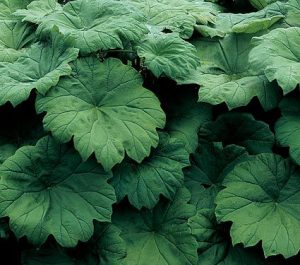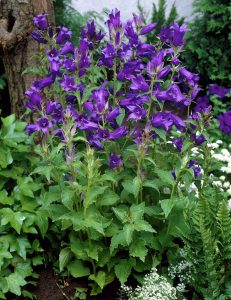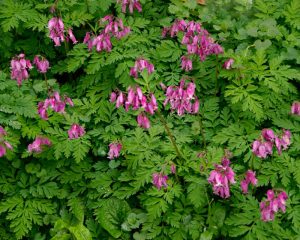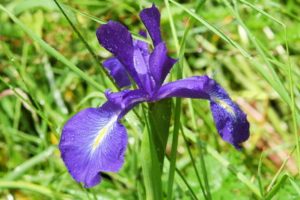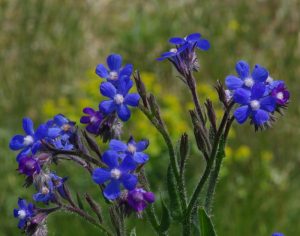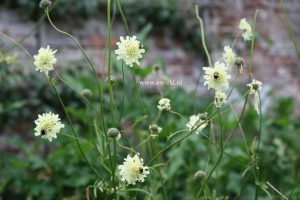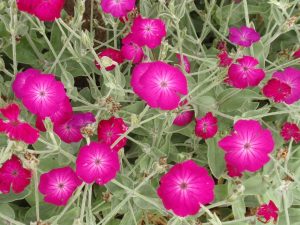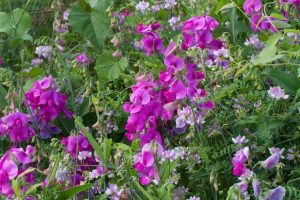List 3
1.Centaurea cyanus
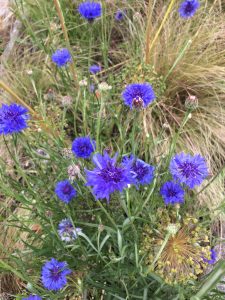
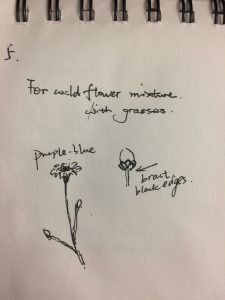
Common name:bachelor’s buttons, corn flower
family name:Asteraceae
USDA Hardiness Zone: 2-11
Mature height and spread:
height: 1-3feet
spread: 1-2feet
Form:easily grown
Water use: medium
Soil requirements: average, medium moisture, well-drained soils
Flower/Cone/Fruit description:Purple-blue flowers (sometimes pink to white) bloom from late spring into summer on 1- to 3-foot tall stems clad with lyrate-pinnatifid lower leaves and narrow lanceolate upper leaves. Each flower (to 1.5” diameter) is subtended an involucre of overlapping bracts. Flowers are attractive to butterflies.
Limitations:Wilt, rots and rusts may occur. Watch for aphids and mealybugs.
suitable uses:Beds, borders, cottage gardens, meadows and prairies. Cutting gardens.
2.Hemerocallis ‘Stella de Oro’
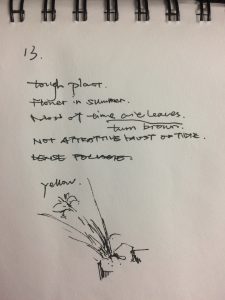
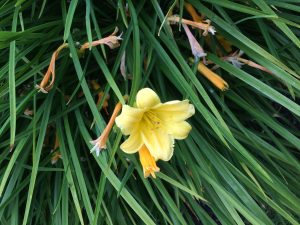
Common name:Stella d’Oro daylily
family name: Xanthorrhoeaceae
USDA Hardiness Zone: 3-10
Mature height and spread:
height: 0-0.75feet
spread: 0-0.75feet
Form:easily grown
Water use: medium
Soil requirements: average, medium moisture, well-drained soils
Flower/Cone/Fruit description:This diploid cultivar features profuse 2.75-inch diameter yellow flowers with ruffled edges and deeper yellow throats. Flower is classified as a miniature. Flowers are borne on naked stems (scapes) above a clump of arching, linear, blade-like leaves.
Limitations:Daylilies are extremely adaptable perennials. They are easy to grow, quick to multiply and virtually pest-free.
suitable uses:Provides color and contrast to the perennial border when grown in clumps or when massed over larger areas. Also appropriate for the rock garden. The fountain-like leaves provide elegant foliage, color and texture for the garden when the flowers are not in bloom. Daylilies can crowd out weeds and form a verdant ground cover.
3.Helictotrichon sempervirens
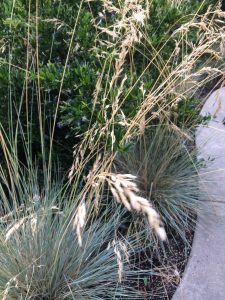
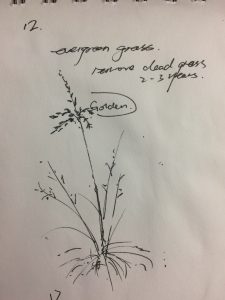
Common name:blue oat grass
family name: Poaceae
USDA Hardiness Zone: 4-8
Mature height and spread:
height: 2-3feet
spread: 2-2.5feet
Form:easily grown
Water use: medium
Soil requirements: average, medium moisture, well-drained soils
Flower/Cone/Fruit description:Blue oat grass is a clump-forming, cool season, ornamental grass which typically grows 2-3′ tall (foliage clump to 2′ and flower stem brings total height to 3′) with a similar spread. Features very narrow (3/8″ wide), spiky, steel blue leaf blades (to 18″) which form a rounded, porcupine-like clump. Resembles blue fescue (Festuca glauca), but is significantly larger. Spikelets of bluish-brown flowers arranged in open, one-sided panicles arching at the tip appear on erect stems rising well above the foliage clump in June. Flower spikelets mature to a golden wheat color by fall.
Limitations:Rust may be a problem in humid climates.
suitable uses:Specimen for the border or rock garden. Mass for ground cover. Effective foundation plant as an accent or in conjunction with dwarf blue spruces or junipers. Blue foliage contrasts well with pink flowering perennials and many spring bulbs.
4.Euphorbia characias
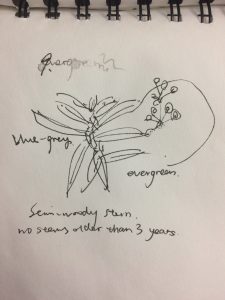
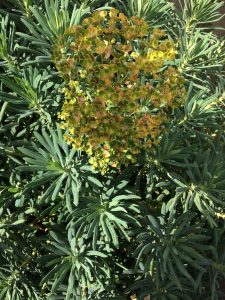
Common name:Mediterranean spurge
family name: Euphorbiaceae
USDA Hardiness Zone: 6-8
Mature height and spread:
height: 2-3feet
spread: 1.5-2feet
Form:upright
Water use: medium
Soil requirements: average, medium moisture, well-drained soils
Flower/Cone/Fruit description: It typically grows on erect, woody-based, green stems to 2-3′ tall and to 2′ wide. Narrow, linear to obovate, blue-green leaves (to 5″ long) are spirally arranged along the stems. Each stem is topped in spring by a thick, bottlebrush-like inflorescense of greenish-yellow flowers with purple glands. Individual flowers lack petals, but have showy, petal-like, greenish-yellow bracts
Limitations:Use gloves when working with this plant because of the toxic plant sap.
suitable uses:Beds and borders.
List 4
1.Campanula persicifolia
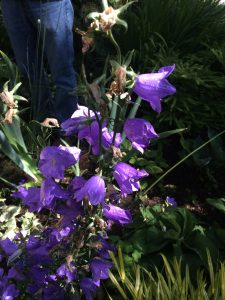
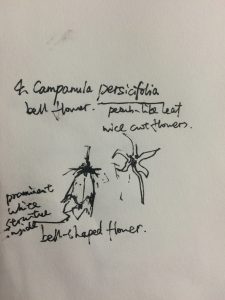
Common name:chimney bellflower
family name: Campanulaceae
USDA Hardiness Zone: 3-7
Mature height and spread:
height: 1.5-3feet
spread: 1-1.5feet
Form: rosette-forming, upright
Water use: medium
Soil requirements: average, medium moisture, well-drained soils
Flower/Cone/Fruit description: Large, outward facing, broad bell-shaped flowers (to 1.5”) in shades of white to blue bloom in open, slender, terminal racemes atop erect, unbranched, nearly leafless stems in late spring to early summer. Stems rise from basal rosettes of narrow, toothed, leathery, bright green leaves (4-8” long). Leaves have a slight resemblance to those of the peach tree, hence the common name. Rosettes are semi-evergreen to evergreen in warm winter climates.
Limitations:Slugs and snails are occasional visitors. Watch for aphids.
suitable uses:Borders. Cottage gardens. Also effective in lightly shaded woodland areas where plants can be left alone to naturalize. Mass or large groups are best.
2.Eryngium giganteum
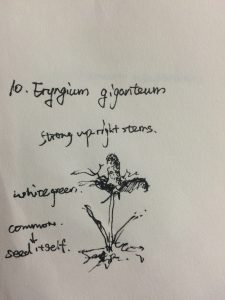
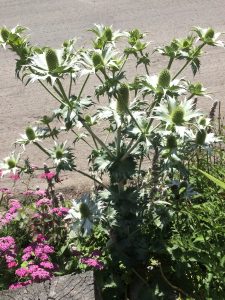
Common name:Mrs. Willmott’s ghost
family name: Apiaceae
USDA Hardiness Zone: 7
Mature height and spread:
height: 0.5-1feet
spread: 0.1-0.5feet
Form: rosette-forming, upright
Water use: medium
Soil requirements: average, medium moisture, well-drained soils
Flower/Cone/Fruit description: Eryngium can be annuals, biennials or perennials with simple or divided leaves, often spiny edged, and cone-like flower-heads often surrounded by an involucre of conspicuous spiny bracts
Limitations:Slugs and snails may be troublesome
suitable uses:Flower borders and beds Cut Flowers Architectural City & Courtyard Gardens Coastal Cottage & Informal Garden Wildlife Gardens
3.Hosta ‘Fortunei Albomarginata’
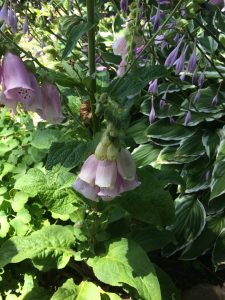
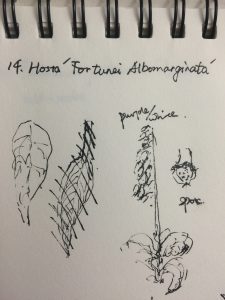
Common name:white mugwort
family name: Asteraceae
USDA Hardiness Zone: 3-8
Mature height and spread:
height: 2-3feet
spread: 3-4feet
Form: clump-forming, herbaceous perennials
Water use: medium
Soil requirements: average, medium moisture, well-drained soils
Flower/Cone/Fruit description: Hostas are primarily grown for their ornamental foliage. Stalked, conspicuously-veined, often dense, basal leaves in a variety of shapes, sizes, colors and textures rise up from a central rhizomatous crown to form a rounded to spreading mound of foliage. Bell or funnel-shaped flowers in terminal, mostly one-sided racemes bloom in late spring or summer atop vertical, unbranched, usually leafless but frequently bracted scapes which rise upward from the crown or rootstock to a point often well above the foliage mound.
Limitations:Leaves are commonly eaten, often voraciously, by deer.
suitable uses:Notwithstanding the often showy flowers produced, hostas are primarily grown in shady areas for the often ornamental excellence of their foliage. This cultivar is effective in small groups or massed. Good background plant. Shady borders, shade gardens or woodland gardens.
4.Verbena bonariensis
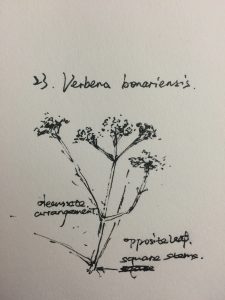
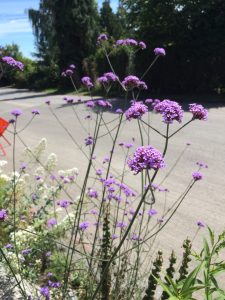
Common name:white mugwort
family name: Asteraceae
USDA Hardiness Zone: 7-11
Mature height and spread:
height: 2-4feet
spread: 1.5-3feet
Form: clump-forming tender perennial
Water use: medium
Soil requirements: average, medium moisture, well-drained soils
Flower/Cone/Fruit description: plants typically form a 1-foot tall basal clump of serrate, lance-shaped, dark green leaves (to 5” long) from which rise erect, slender, wiry, branching, sparsely-leaved, 4-angled stems to 3.5’ tall bearing clusters (to 2” across) of tiny rose-violet flowers. Blooms mid summer to fall.
Limitations:Watch for powdery mildew.
suitable uses:Group or mass in mixed borders, meadows, cottage gardens.
